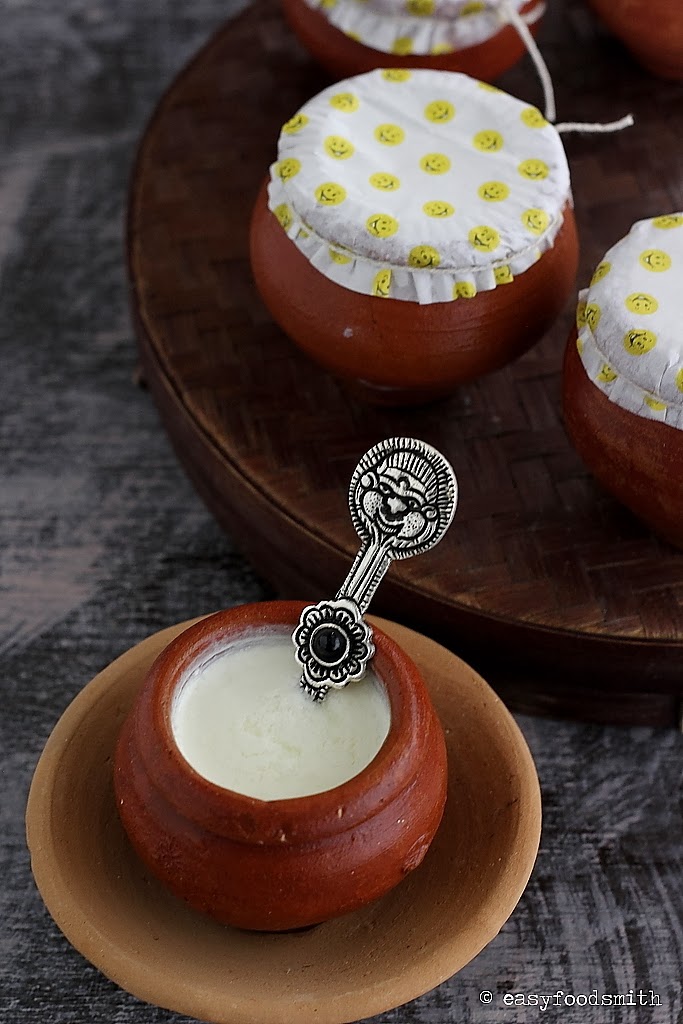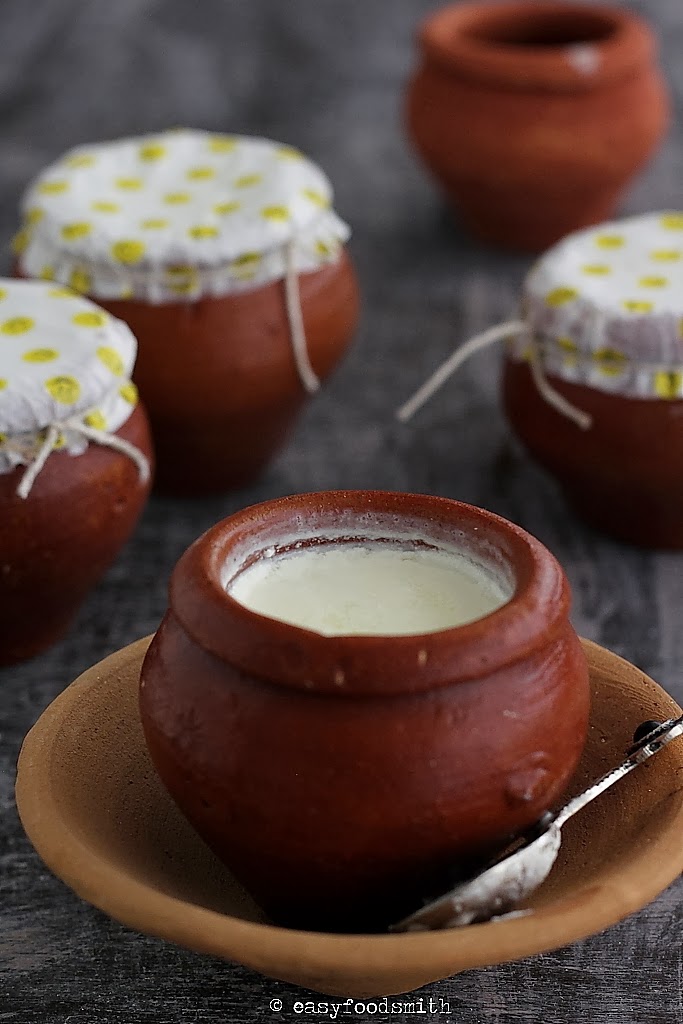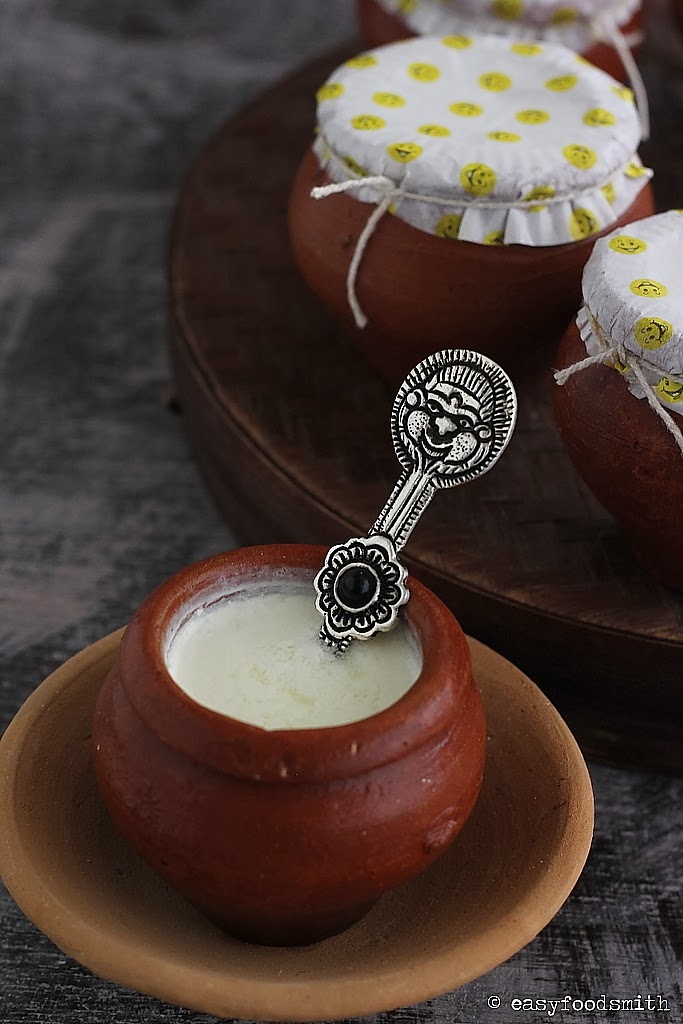Yogurt has been an integral part of the Indian cuisine and culture. Most Indian households prefer making dahi at home than buying the store ones. No one knows how long yogurt has been the part of an ordinary Indian’s life. Ancient Indians believed that a mix of yogurt or dahi along with honey was food fit for Gods. Even today, Hindu temples offer ‘charanamrit’, a mix of honey, milk (or water from the holy Ganges river), dahi, a little ghee and basil leaves to the devotees who visit the temple as ‘a sacred offering’. The literal translation of the word is holy nectar from the feet of the holy deity. I never ever liked its taste though and I would just touch my lips to it and give it away to my mother.
However, I used to love plain yogurt; actually sweet curd is something I could never develop a taste for. After my daughter insisted that I try the flavoured ones with fruits, I have sort of developed a taste for the sweet one yet given a choice I still prefer a savory raita or a savory lassi. As a child I virtually lived on yogurt. Mum once told me how I often demanded it for breakfast, lunch and dinner! However when Mum told me that yogurt was bacterial fermentation of milk, I looked upon the yogurt with suspicion and stopped eating it for a while!
Yogurt is an extremely healthy food. Rich in protein, calcium, vitamin B6 & B12, riboflavin (info derived from Wikipedia), yogurt is a valuable food for infants and elderly people too. It is a good source of protein, carb, mineral and fat. It is good for the stomach too and helps develop the good bacteria in the gut and aids in digestion. Apparently lactose intolerant individuals can tolerate yogurt better than milk. My granddad was lactose intolerant but he used to enjoy the yogurt without any discomfort. Ayurveda considers dahi to be a cooling food; hence people consume large quantities here during the hot sultry Indian summers. Not only is it consumed, but it is also applied to the face as it provides relief from suntan and sun burns too.
There are over dozen ways in which you can use yogurt. Here are a few simple suggestions where you can use yogurt – smoothies, parfaits, creamsicles (try this Strawberry Chia seeds Creamsicle or this desi Mishti Doi Creamsicle), cheesecake, frozen yogurt, shrikhand, fruit yogurt, dips, salad dressings, marinating lamb or chicken, making curries, baking, desserts, labne, lassi, raita, cold soups. I use them even in the Coconut Chutney and this Pesto Dressing. My sour batch of yogurt was used to make this Masala Spiced Beet Lassi.
Making yogurt at home is a simple process; no special equipment (perhaps beside a thermometer) or vessels are required. However, don’t feel discouraged if you don’t get a smooth thick yogurt in your first attempt. The milk needs to be heated up to approx. 80-82 degrees C to kill any undesirable bacteria and then cooled to approx. 39-43 degrees C. Plain yogurt with active bacterial culture is added to the milk, temperature is maintained and it is set aside for 4-7 hours or over-night to ferment and set. A lot depends on the humidity and temperature of the place. During cool days I wrap the container in a kitchen towel or a regular towel. If the curds are still not set, I place the container (if using metal one) in warm bath till the curds are set. You may also heat the oven up to 50-60 degree, switch it off and keep the towel wrapped container in the oven overnight or till the milk is set.
Here is the process with specified amount of ingredients to be used…
½ litre milk (pre-boiled)
2 tbsp commercial yogurt with active culture (I use Nestle or Amul or Mother Dairy depending on availability)
Heat the milk in a sauce pan and bring the milk to 80 degree C temperature.
Remove the pan and bring down the temperature to approx 40-42 degrees temperature. For those not having thermometer, the milk should feel warm on touch.
Transfer the milk in the container in which you intend to ferment/ set it.
Remove a little milk (3-4 tbsp approx) from the pan and mix in the yogurt. Beat till there are no lumps visible.
Gently pour and mix this mixture into the rest of the milk and cover the container with a lid. Wrap the container in a towel and let the milk ferment undisturbed for at least 4 hours.
Once the curds are set, refrigerate it immediately. It is best to let it cool for at least 2-3 hours before you consumer it. Refrigeration further thickens the curd and sets it even better.
Note:I usually boil the milk and refrigerate it. To make the yogurt, I remove it from the refrigerator and slowly bring it to the temperature of 80 degrees C.
Note: The amount to ferment the milk will vary from place to place. It takes no more than 3-4 hours here in the warm and humid weather of Mumbai (India). In peak summers it takes just 2 hours!
Note: You may use low fat or full fat milk for making yogurt.
Note: The longer the fermentation time, the sour the yogurt would be
Note: If you like the yogurt sweet, feel free to add some sugar in the milk before leaving it to ferment.
Note: To turn this yogurt into a Greek Yogurt, line a large sieve with a muslin cloth and pour the yogurt onto it. Bring the ends of the cloth together and tie into a knot. Let the wsater drain from the curd in a refrigerator for at least 7-8 hours or overnight. Do not forget to put a container underneath the sieve.
_________________________________________________________________________________
I am so happy to announce the first giveaway at EFS. The book that I selected for the giveaway is an extension of my belief that home-made food is tastier, healthier, cheaper and oh so gratifying!
The book – “The Homemade Pantry-101 Foods You Can Stop Buying & Start Making” is all about food that you can make right in your kitchen – from crackers to cheese, pesto to sauerkraut, and mayonnaise to toaster pastries, breads and candies. The author has thrown in humour and her personal anecdotes which gives a friendly appeal to the reader.
The giveaway is open worldwide. All you have to do is leave a comment saying that you wish to enter for the giveaway. So hurry leave a comment and ensure that you do that before 7 p.m. Indian Standard Time, 17th August 2013.
The winner will be announced on the 17th of August 2013.
Thanks for visiting and see you soon again!
IT IS ALWAYS ENCOURAGING TO HEAR FROM FRIENDS AND READERS. I CAN ALSO BE REACHED AT: easyfoodsmith@gmail.com





I wish to enter for the giveaway! I’m a blogger blogging at http://enelm.blogspot.de/
Home made yogurt looks delicious… 🙂
Love your yogurt jars :-))
Thanks Angie…they are the humble earthen pots & I love them too 🙂
Setting curds in the traditional earthenware!Taruna, I just love ur style and ideas.
I had so much trouble finding the right starter curd here now ur post tempts me set it in earthenware.Hmm…will have to go home to get that 🙁
I wish to enter for the giveaway.
Thanks so much dear. The earthen pots are ideal for fermenting the curd. They keep the curd cool once it is set. I love their rustic appeal 🙂
I’ve never made yogurt, but I’d love to try it. I’ve been experimenting with other types of fermentation, so I need to try yogurt too!
Once you will start making your own, you will find it so much better than store brought ones.
Thank you so much for this post. I always wanted to make my own yoghurt as the ones I like are hard to find here.
Now I’ve even learned how to prepare greek yoghurt, can’t want to try it out.
Would like to entre for the giveaway 🙂
Nothing like home made stuff Daniela! I hope you do try it 🙂
I always take the easy way out, buy the yogurt. Of course the home made ones will still be the best. I use it for curries and other dishes as well. Wonderful giveaway, the book is certainty interesting.
Curd looks perfect and thanks for recipe…
Great giveaway! I’d love to win this 🙂
Wonderful! Your yogurts look perfect.
Thanks for the giveaway. I’d love to participate in it…
Cheers,
Rosa
Homemade yogurt is still one of those recipes that I must try. Thanks for sharing! I ‘m loving the little smiley faces by the way!
Thanks Vanessas!
Wonderful post!! I adore your yogurt containers….they are beautiful. Yogurt is indeed very healthy… it should be eaten every day. 🙂 I have never made homemade yogurt.. but you are certainly tempting me to do so now.
PS… fantastic giveaway.. count me in. 🙂
Thanks Ramona. In fact it is a daily feature in our meals. Once you start making it at home, you just wouldn’t want to buy it from the store.
Yogurt is very important in Greek kitchen too! I love it and could eat a ton haha! Great giveaway, I would love to participate!
Me too! I can have it with all three meals of the day!
Homemade yogurt is the best. I have been making a lot of cheese lately but only one yogurt recently. You inspire me to make more. I love these kinds of book with such recipes.
Me encanta el yogurt natural pero hace tiempo que no lo hago casero se ve super bonito y exquisito,hugs,hugs.
Thanks for sharing an elaborate and useful post! Lovely giveaway…
My husband makes the easiest yogurt and I love it! 🙂 Nice giveaway!
Yogurt is actually quite simple to make.
Having gotten used to making it since long, I can gauge the temperature by using my index finger. It takes not more than a few minutes to do the job.
Pretty darn cool that you made your own yogurt! And I’d love to win the cookbook…thanks for the opportunity!
Yogurt is an integral part of our Indian meal. And yes, I would love to participate in the giveway. Would like to gift it to my daughter.
I really like yogurt.. Loved the clicks… Thanks for sharing.. Lovely giveaway with such a book with variety of recipes.. I would surely love to participate dear 🙂
For me, yoghurt is a must during lunch. Nice and useful post. Loved those tiny yoghurt pots.
Thank you for posting this homemade dahi recipe! I have never tried it – but just might now 🙂
Shashi @ http://runninsrilankan.com
I hope you do it soon 🙂
You make yogurt making sound so easy. I love the vessels you put the yogurt in and the special coverings. They’re so beautiful I’d almost hate to eat from them.
Nice post. Very informative and your book sounds like fun.
It is actually very easy Vicki. Do it 2-3 times and you will get the hang of it.
Thanks 🙂
i would make yogurt before from milk, now i make yogurt from cashews 🙂
i loved those mud pots and the cute wrappers on top. i would love to participate in your blog’s first giveaway.
That is so cool! Cashew yogurt!
Am in love with ur earthern post, they looks dam cute.. Dunno why i never tried making yogurt at home,have to make some soon.. I would love to be a part of ur giveaway too..
Thanks Priya. My dear you don’t know what you are missing! Nothing beats home made yogurt. Do try it 🙂
Love the earthen jars!!I have enjoyed mishti doi from many of those back in India 🙂 I have yet to make my yoghurt at home and thanks to this post I’m inspired to try it now 🙂 Would love to participate in your giveaway 🙂
Earthern pots are actually the traditional vessel to ferment and store yogurt but also butter and butter milk. It keeps the contents cool even during hot summer days.
Yogurt is such a important part of Indians. I really love the spoon you’ve use to, quite fancy. I make yogurt everday from scratch and nothing like that. Congrats on your first giveaway, the books sounds interesting.
Good luck to those entering the giveaway! What a lovely homemade yoghurt, it is so refreshing 😀
Cheers
CCU
I have never made yogurt before – such a great idea! Yours looks sooo delicious and beautiful, and that book sounds wonderfully handy to have around!
Love your matke, so cute! I’ve made dahi before but here, it doesn’t cost much more to buy a good quality organic one, so I rarely do. Homemade is awesome though and like you I am not too fond of sweet ones.
I want to win your book! Good luck with your giveaway!
Nazneen
Thanks Nazneen.
It makes sense to buy the organic curd when it is cheaper. The same goes for paneer here. It is readily available in Indian at a decent price and I seldom make it at home.
Beautiful matke’s. So adorable!! THere’s nothing like homemade yogurt 🙂
So very well written post! Thanx for all the details about yogurt . It was very informative.
The book looks very interesting and exciting! Its a wonderful and thoughtful giveaway for your blog.
It reminds me of the chinese proverb: ” Give a man a fish and you feed him for a day, teach a man to fish and you feed him for a life time ”
I’d love to teach myself to fish through this book !! Yes , I wish to enter for the giveaway .
Ha ha ha… Absolutely. You appropriately summed up the book using the Chinese proverb.
Making yogurt at home is easy, simple & cheap too. Thank you dear for the tips, loved how you presented it 🙂
I have not made yogurt in years…and the matke are so cute…
Great giveaway 😀
Hope you are having a fun week my dear!
Totally agree with your believe that “home-made food is tastier, healthier, cheaper and oh so gratifying!” That’s very well said. Your homemade yogurt sounds wonderful. Can’t wait to try it. Thanks for hosting the giveaway, I would love to win this awesome book. Sounds like a must have for all the home cooks! 🙂
amy [at] utry [dot] it
Thanks for the post. We love yogurt!
Also, I would love to be entered for this giveaway 🙂
I’m so glad you posted this. I have a yogurt maker I used to use all the time. I need to get that out again. The yogurt was so much more flavorful than the store purchased variety.
You have prompted me to try to make my own yoghurt, it is a staple we always run out of and so being able to make it ourselves would be amazing.
Wow you made homemade yogurt!! It must be so delicious. I’m too lazy to do it but one day I really want to try making everything from scratch. Love your smiley face package too! 🙂
Loved the recipe
mouth watering.
Curd is very tasty and delicious